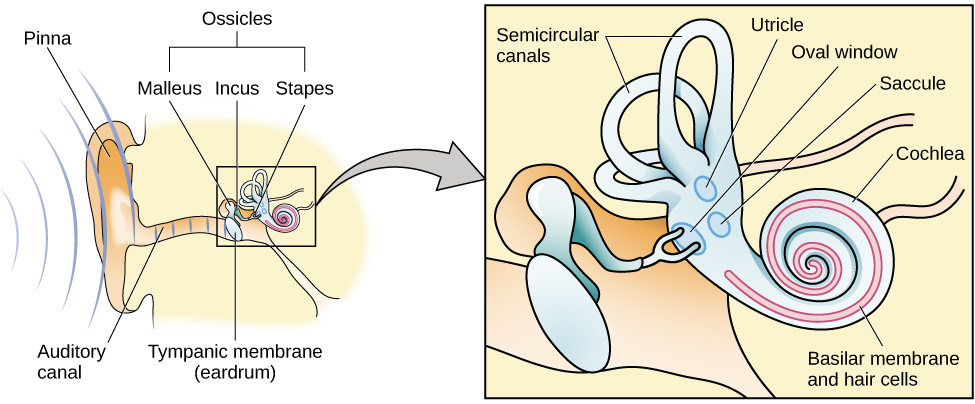The Mechanics of Hearing
50 The Inner Ear
Learning Objectives
Be able to explain what the inner ear comprises (cochlea and vestibular organs).
Know the basilar membrane in inner ear and whether high frequencies are at the base or the apex.
The inner ear includes the cochlea, encased in the temporal bone of the skull, in which the mechanical vibrations of sound are transduced into neural signals that are processed by the brain. The cochlea is a spiral-shaped structure that is filled with fluid.
One of the most important principles of hearing, frequency analysis, is established in the cochlea. In a way, the action of the cochlea can be likened to that of a prism: the many frequencies that make up a complex sound are broken down into their constituent frequencies, with low frequencies creating maximal basilar-membrane vibrations near the apex of the cochlea and high frequencies creating maximal basilar-membrane vibrations nearer the base of the cochlea. This decomposition of sound into its constituent frequencies, and the frequency-to-place mapping, or “tonotopic” representation, is a major organizational principle of the auditory system, and is maintained in the neural representation of sounds all the way from the cochlea to the primary auditory cortex.

The place theory of pitch perception suggests that different portions of the basilar membrane are sensitive to sounds of different frequencies. More specifically, the base of the basilar membrane responds best to high frequencies and the tip of the basilar membrane responds best to low frequencies. Therefore, hair cells that are in the base portion would be labeled as high-pitch receptors, while those in the tip of basilar membrane would be labeled as low-pitch receptors (Shamma, 2001).
References:
Shamma S. On the role of space and time in auditory processing. Trends Cogn Sci. 2001 Aug 1;5(8):340-348. doi: 10.1016/s1364-6613(00)01704-6. PMID: 11477003.
CC LICENSED CONTENT, SHARED PREVIOUSLY
OpenStax, Psychology Chapter 5.4 Hearing
Provided by: Rice University.
Download for free at http://cnx.org/contents/4abf04bf-93a0-45c3-9cbc-2cefd46e68cc@5.103.
License: CC-BY 4.0
NOBA, Hearing
Provided by: NobaProject
URL: https://nobaproject.com/modules/hearing#content
License: CC BY-NC-SA 4.0

